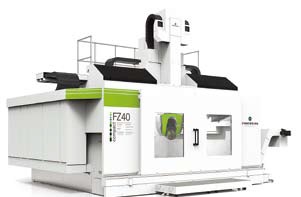
Daniel Demlang, Deputy Head of Design Engineering and Development at F. Zimmermann GmbH: “Because users are covering an ever wider range of needs, they need the corresponding machines that offer an even wider spectrum of capabilities.”
Whereas, in the past, they often specialised in the machining of certain materials such as aluminium, plastics, Ureol or carbon-fiber/glass-fiber reinforced plastics, they now have to cover a much wider spectrum if they are to remain competitive. The automotive industry, in particular, needs high-quality steel injection moulding tools. However, due to space constraints and often also to financial considerations, manufacturers are committed to lean machine pools. What they want therefore are multi-purpose systems, i.e. high-performance cutting solutions that can efficiently mill not only easy-to-handle but also tough materials. Daniel Demlang, Deputy Head of Design Engineering and Development at F. Zimmermann GmbH, knows all about the challenges facing his customers – and also knows the solutions.
“If they are to win orders, model, mould and tool makers must be extremely flexible,” explains Demlang. “One day they manufacture moulds for mobile phone cases, the next for shampoo bottles and the day after complex steel tools, for example, for front spoilers, bumpers or fenders.” So, whatever the task is: The customer must be supplied with tools reliably, quickly, in the precise dimensions required and with a high surface quality. “As machine makers, we must be able to give our customers this flexibility,” says Demlang.
It had become increasingly frequent for model and mould makers to approach Zimmermann with workpieces made from high-strength materials so that the specialist could perform the corresponding milling tests. The company’s experts soon realised what the future holds: “Because users are covering an ever wider range of needs, they need the corresponding machines that offer an even wider spectrum of capabilities,” explains Demlang. Since 2013, the F. Zimmermann product portfolio has included the FZ33 compact. What makes it different is its inherently rigid monoblock structure. The side walls are filled with special concrete and rest on the machine bed. This makes it possible to locate the machine on a solid industrial floor – usually without special machine foundations. Users thus have greater flexibility when setting it up. The portal milling machine is also very well suited for the full 5-sided machining of parts without the need for any reclamping. “In the past, operators had to reclamp the parts and possibly also use other machines,” says Demlang. Now, thanks to the faster throughput, they can save a lot of time and increase efficiency. What is more, the FZ33 compact represents outstanding value for money. Although it is possible to process steel, the focus is on the machining of aluminium and the system can be used to mill all model-making materials.
Machining steel? An exacting task!
The topic of high-performance cutting (HPC) is playing an ever more important role in companies that need to machine steel efficiently and economically. HPC is a method that offers considerably higher material removal rates than conventional machining processes thanks to the faster cutting and feed speeds. “When it comes to steel-working, many manufacturers still think that strong and very strong materials can only be machined efficiently by using very high torques, low speeds and high cutting depths. However, it is a long time since the cutting insert geometries of the milling tools were designed for this type of approach. By contrast, it is possible to achieve high material removal rates with low cutting depths and very high feed speeds – without it being necessary to use a relatively powerful but slower machine,” explains the Zimmermann developer. The important thing is to adapt the dynamics of the process to the system – that is the way to achieve outstanding surface quality. “Our aim was to develop a highly efficient milling head for steel machining that we could use in a compact portal milling machine,” explains Demlang, pointing to the flexibility demanded by customers. What is more, purchasing a new machine involves considerable costs. In a word: The system must pay for itself.
It all depends on the (milling) head
“Economical production always depends on the workpiece throughput times,” explains Demlang. “And these can be minimised by ensuring high spindle power.” The powerful new VH60 2-axis milling head achieves an impressive torque of 300 Nm (221 ft lb), and the spindle power is 63 kW (84 hp) at a maximum spindle speed of 15,000 rpm. With its modular head system, Zimmermann offers a range of solutions. The standard variant is a fixed universal spindle for roughing and finishing work. However, as an option, the machine maker can also equip the milling head with a spindle-change system: In this case, roughing and finishing work are performed using separate, specialised spindles. These can be installed in the head using an insertion cartridge. This is done either fully or semi-automatically depending on the user’s preferred mode of operation. Another alternative when machining steel is to use a roughing spindle rotating at 8,000 rpm and providing 50 percent more torque than the universal spindle.
According to Demlang, “in the new milling head, we have also increased the retaining forces and boosted the torque.” The HSK-A100 is used as tool holder. The head also accelerates and swivels more dynamically. “Initially, we wanted to integrate the VH60 in the existing FZ33 compact machine concept. However, because the head was designed for high feed speeds, it is relatively large, and too large for this machine. Far too much leverage is exerted and this makes it unsuitable,” says Demlang.
Strong even with the toughest materials
An equivalent machine to the FZ33 compact was developed under the name FZ40 compact – however, this solution is not just extremely suitable for machining aluminium and plastic but also for steel and is characterised by its compact design, economic efficiency and, most importantly, its versatility. For this series, Zimmermann has chosen a larger, more rigid portal. It has also provided a larger cross slide and designed a vertical slide specifically for the VH60 milling head that has been newly developed for machining tool steel. “We also make use of Heidenhain’s adaptive feed control,” explains Demlang. “As a result, the system detects the areas on the part that require more power.” The FZ40 compact automatically regulates the feed rate as a function of the power of the spindle that is being used and other process data, and does so independently of the NC program.
 Automating the path to success
Automating the path to success
And what does the future hold? For Daniel Demlang, nothing could be clearer: “The question of automation will become even more pressing in the future because it will allow users to reduce their costs still further.” What is now a self-evident feature of the horizontal machining centres will become more widespread in the portal systems? This depends, of course, on whether companies process individual orders one by one or whether they cover a range of different orders and manufacture a wide variety of parts. However, automation can reduce idle times even for companies that manufacture small or very small runs. “The problem with the normal, conventional portal machine is that productive time includes all the idle and setup times,” explains Demlang. “The machine throughput times can be as short as you want but that doesn’t help one bit if you constantly have to waste time laboriously clamping and unclamping the workpiece.”
En route for Industry 4.0
While modern portal machines have now achieved such a high level that optimisations in terms of performance and dynamics are little more than details, the question of service is becoming ever more important. After all, what characterises a good relationship between supplier and user? Demlang knows the answer: “Customers expect high uptimes across the entire system lifecycle. That is why we offer a comprehensive service solution. This includes a hotline that is available even outside of normal working hours, as well as a remote diagnosis system that allows us to respond extremely quickly whenever an urgent situation arises.” What is more, Zimmermann’s application engineers work together with the customers to optimise each individual combination of heads, spindles, tools and clamping equipment. “We don’t just sell systems, we offer end-to-end solutions,” promises Demlang. “Because the machine is always part of the whole.”
To further improve service, the developers are currently working on an app that will display the machine state to the customer at all times. If an error occurs, the user immediately sees a message that is sent directly to Zimmermann. “This is one way of further enhancing our networking,” emphasises Demlang. “We don’t think it’s enough to equip all the components with sensors and record the data. We must also know how we can further process this data appropriately.” State-oriented maintenance plays a vital role in ensuring high machine availability. The important thing is to know when the machine needs maintenance. This can be identified, for example, through a change in the drive characteristics. “A combination of the required data, the right analyses and our experience tells us, for example, that the drive will run for at most another five weeks,” explains Demlang. “This allows users to schedule the necessary measures in good time.” It also helps keep unscheduled downtimes to an absolute minimum. The app is currently in the design phase. It is also part of what Zimmermann understands by Industry 4.0.
It also raises the question of how much networking is worthwhile for each individual company. A company with five employees and two machines does not need a connected master computer together with associated analytical options. By contrast, this is very important for a series manufacturer in the aviation industry running 20 machines and equipped with extensive automation capabilities. “Both types of company number among our customers and we are determined to offer each of them the solutions they need,” promises Demlang.
Nike Hypervenom Phantom













